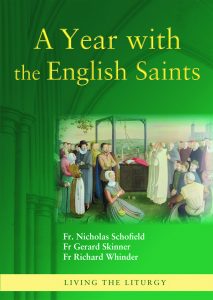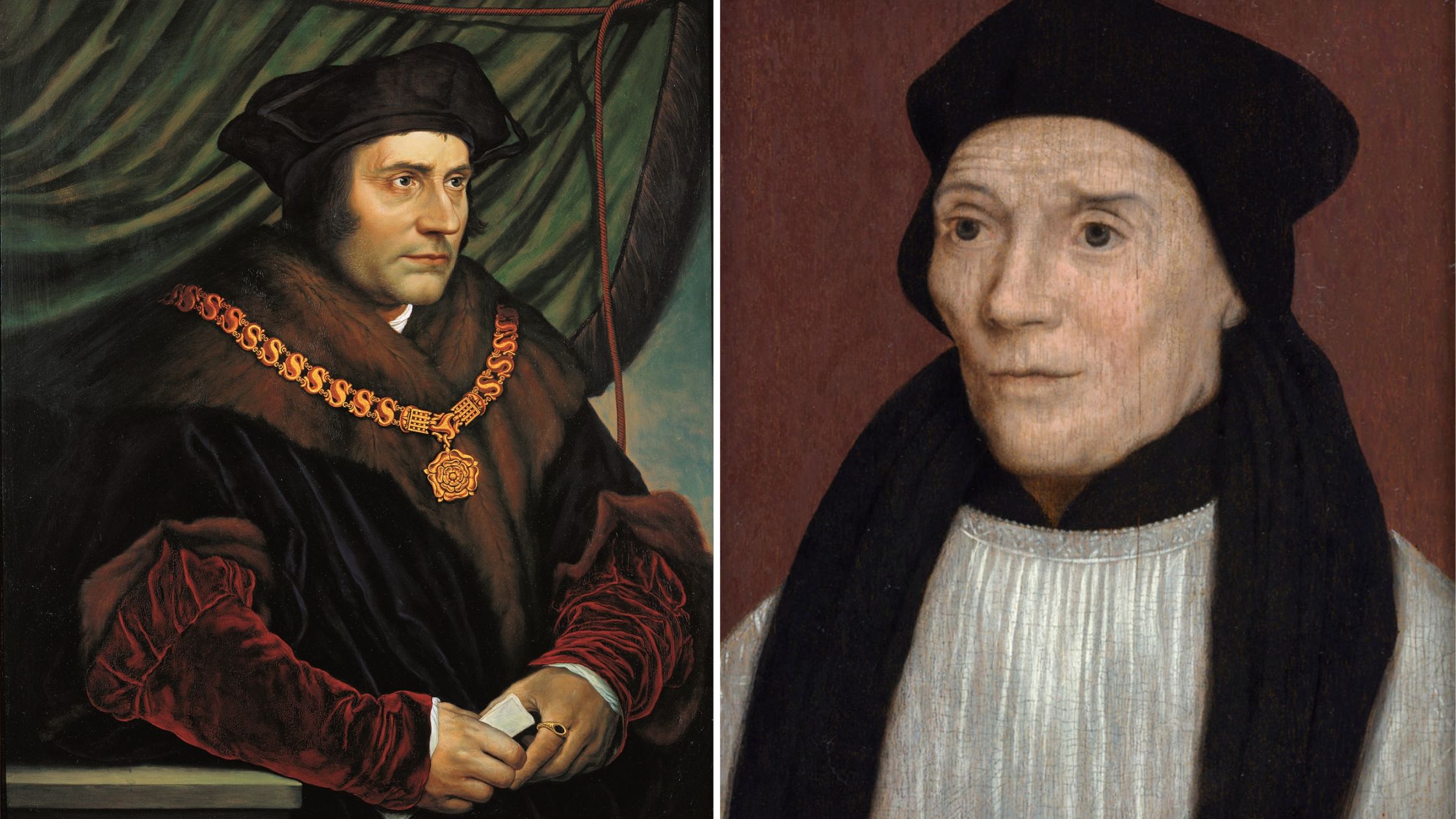These most famous of the Reformation martyrs were also the first to be canonised, being raised to the altars by Pope Pius XI in 1935; St Thomas More was proclaimed Patron of Statesmen on 5 November 2000, during the celebration of the Great Jubilee.
St John Fisher
St John Fisher was born at Beverley, the son of a draper, and educated at Cambridge university from the age of fourteen. At Cambridge he flourished as a renowned scholar, being elected as a Fellow of Michaelhouse (now Trinity College) and ordained priest in 1491. As his reputation grew, he held a series of increasingly important appointments both within his college and within the university, being appointed Chancellor of the university in 1504, the same year he was consecrated as Bishop of Rochester. Some years earlier, in 1502, he became chaplain to Lady Margaret Beaufort, the King’s mother, also becoming in that year the first Lady Margaret Professor of Divinity at Cambridge. Between them, they refounded the university both financially and academically. Fisher introduced Greek and Hebrew into the curriculum and invited the famous scholar Erasmus to lecture.
Zealous Defender of the Church
As Bishop of Rochester, England’s smallest see, Fisher was ardent in his pastoral care and particularly noted for the power of his preaching. He complemented his scholarship with his devout life and was thus well equipped zealously to defend the Church and its Sacraments against Luther’s attacks. Even Henry VIII boasted that no other realm could claim such a distinguished prelate. During this time Fisher had been appointed chaplain to Henry VIII’s wife, Catherine of Aragon.
As one of the king’s most admired bishops, John Fisher had no escape from clearly declaring his mind with regards to the validity of King Henry’s marriage. To do so made him a marked man. The matter first arose regarding the nullity suit of 1529, but it was not until 1534 that all public officials were required to swear to a form that the marriage of Henry and Catherine was illegal and invalid. Bishop Fisher, alone among the English bishops, was unable to do this, although he declared that he would be willing to swear allegiance to the succession of the children of Anne Boleyn. For this he was condemned to imprisonment in the Tower of London. In the intervening years between 1529 and 1534, he had protested against the title ‘Head of the Church of England’ for Henry VIII and had qualified it with the words ‘so far as the law of God allows’. Earlier in 1534, before he was presented with the Oath of Succession, he had been threatened with imprisonment for the alleged encouragement of Elizabeth Barton, a young nun of Kent, who claimed to have been granted visions which prophesied divine retribution for King Henry if he divorced Catherine and married Anne Boleyn.
Red Robes and Spilling Blood
Imprisoned in the Tower, Fisher was deprived of the university Chancellorship and the See of Rochester. For a bishop of genuine asceticism, his letter to Thomas Cromwell, the Secretary of Henry VIII, makes poignant reading, so utterly deprived had the bishop been of clothes and food. But most cruel of all was his deprivation from receiving the sacraments and any priestly visitation.
The final days of his earthly life were marked by the newly elected Pope Paul III creating Fisher a cardinal. To many this has seemed a politically inept move – Henry responded by vowing that Fisher’s head would be off before the Cardinal’s hat would be on – but if the scarlet cardinalatial robes are supposed to remind the wearer of his promise to defend the Church to the spilling of his blood, then the honour bestowed on Fisher was indeed a timely one. Fisher was ready for this self-sacrifice.
Death
On 22 June 1535, John Fisher was taken from the Tower to the scaffold on Tower Hill. Pardoning his executioner and clearly announcing that he was dying for the faith of the Catholic Church, he asked those nearby to pray for him. Praying the Te Deum and a psalm, he rested his head on the block and, with a single blow of the axe, he died.
Fisher’s body was buried in the churchyard of All Hallows at Barking, but was soon exhumed and taken to be buried with the body of Thomas More in the chapel of the Tower in order to deter people from regarding his grave as the shrine of a saint. For a fortnight his head was displayed on London Bridge before being thrown into the Thames.
St Thomas More
Being held in the Tower at the same time as John Fisher was Sir Thomas More, also a former man of state whom Henry VIII raised up only to throw down again.
Thomas More was son of Sir John More, one of the Justices of the King’s Bench. He was born in 1478 in London. At the age of thirteen he was taken into the household of John Morton, the Archbishop of Canterbury (from 1486 to 1500) from whence he was sent to Canterbury College, Oxford (now incorporated into Christ Church). After returning to London to read Law at Lincoln’s Inn, he was called to the Bar in 1501. Three years later More entered Parliament.
Widowed
Before marrying Jane Colt in 1505, More had seriously considered whether or not he was called to the religious life. During this time he lived for four years at the London Charterhouse. Although he decided that his was not a vocation to a religious order, for the rest of his life More embraced many pious practices such as wearing a hairshirt and reciting the Little Office.
Jane More died in 1511, leaving Thomas with three daughters and one son. He remarried only a few weeks later, taking for his second wife Alice Middleton, who had herself lost her first spouse. The family life of the More household is legendary, immortalised by the famous painting by Hans Holbein. Thomas was as good a father as he was a lawyer, known for his strong commitment to the responsibilities of the former, as he was renowned for his integrity with regards to the duties of the latter. But it was his professional qualities that quickly came to the attention of the newly crowned Henry VIII, and thus Thomas rose swiftly in public office until in 1529 he succeeded the ill-fated Cardinal Wolsey as Lord Chancellor of England.
The King’s Good Servant
Throughout this time, More’s reputation as a man of letters increased around Europe. Most notably his book Utopia was translated from the original Latin into the principal European languages. His wit and wisdom, however, was completely full of common sense, and if anyone was fooled by King Henry’s munificence, More was not. ‘If my head would win him a castle in France’, he said, ‘it should not fail to go.’
It was for no castle, however, that More’s demise was to come about, but for the same reasons, with much the same chronology, that John Fisher (whom More greatly admired) came to his earthly end. Having resigned the Lord Chancellorship, More was impounded in the Tower on 13 April 1534, his lands confiscated and his family impoverished. Fifteen months later, on 1 July, he emerged from the Tower, a shadow of his former self, to be tried at Westminster Hall. He gave a robust defence, but was sentenced to death, a sentence executed on Tower Hill, on 6 July 1535, by beheading. To his beloved daughter, Meg, he wrote, ‘Farewell my dear child, and pray for me, and I shall for you and all your friends, that we may merrily meet in heaven.’ As he mounted the scaffold his last words were that he died for the faith of the Holy Catholic Church and was ‘the king’s good servant, but God’s first’.
Places to Visit
The Tower of London, where both were imprisoned, and nearby Tower Hill where the executions took place. The seminary of Allen Hall is built upon the site of the More family home, and the nearby church where the saint worshipped preserves a monument of him. Rochester Cathedral was the Episcopal See of St John Fisher.
Quotes of St Thomas More and St John Fisher
I die the king’s good servant, but God’s first.
The last words of St Thomas More
I am come here to die for Christ’s Catholic Church. And I thank God…
The words of St John Fisher from the scaffold
 This blog is extracted from our ebook A Year With the English Saints. This booklet offers brief biographies of the saints of the English calendar combining familiar saints such as Thomas Beckett and Edward the Confessor with less familiar ones from the nation’s history.
This blog is extracted from our ebook A Year With the English Saints. This booklet offers brief biographies of the saints of the English calendar combining familiar saints such as Thomas Beckett and Edward the Confessor with less familiar ones from the nation’s history.
Discover more English saints and be inspired by their lives by downloading your copy of A Year With the English Saints from your preferred ebook platform today.
